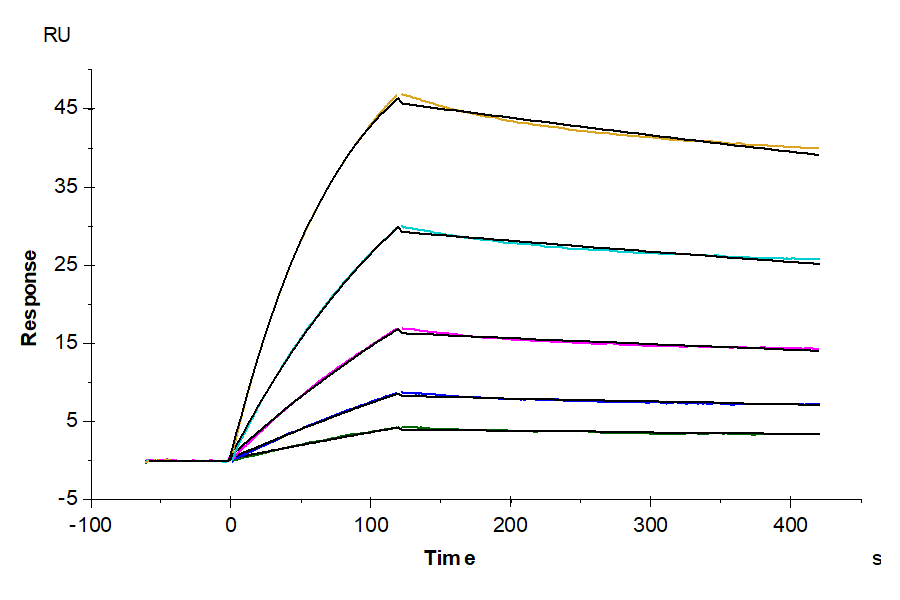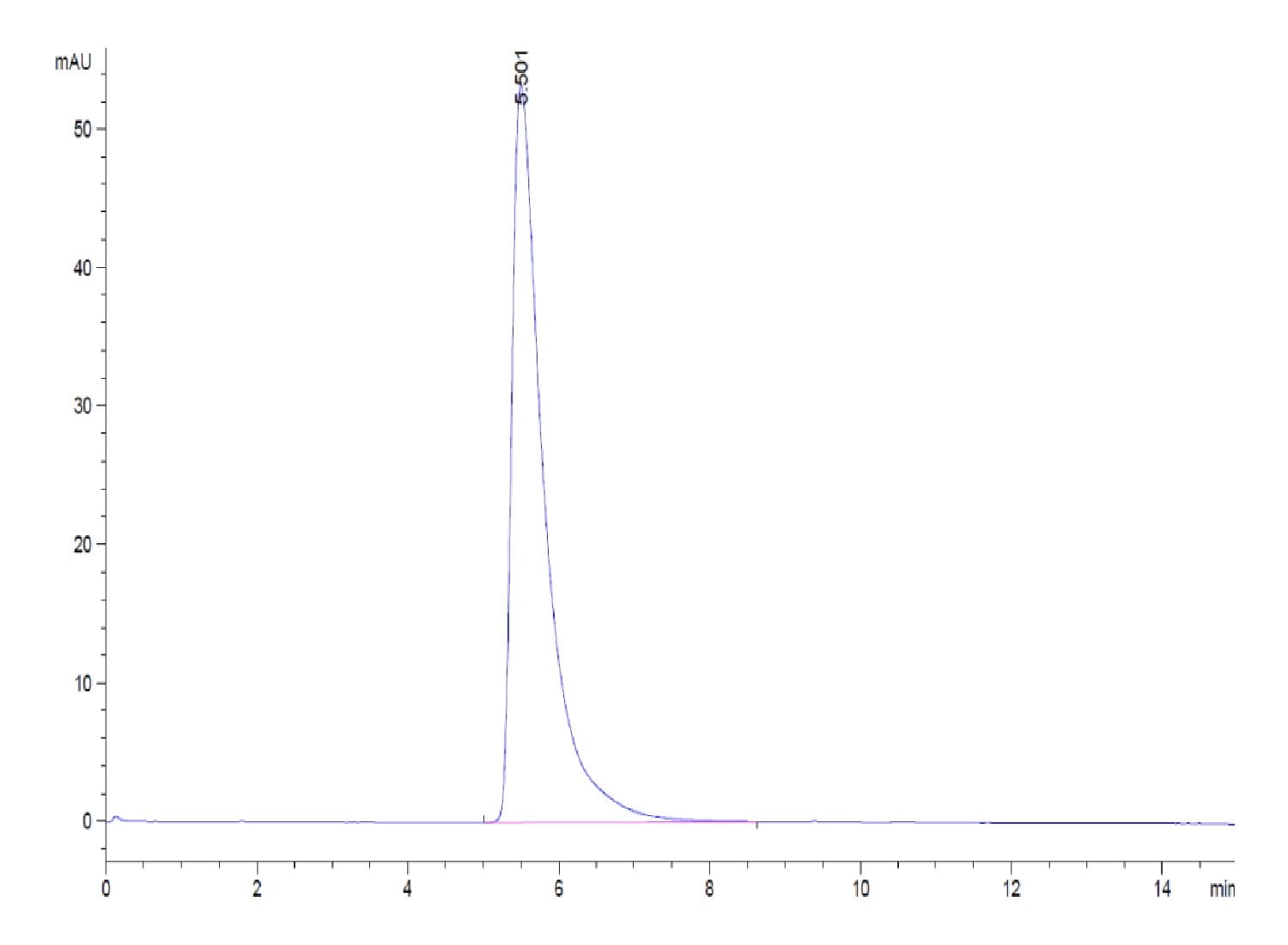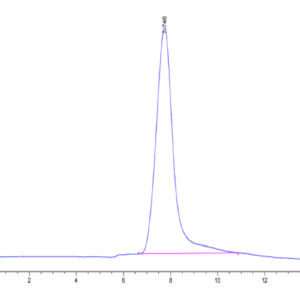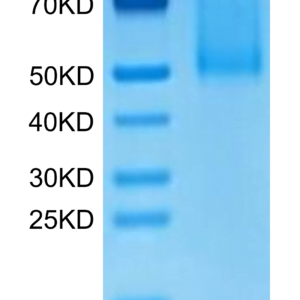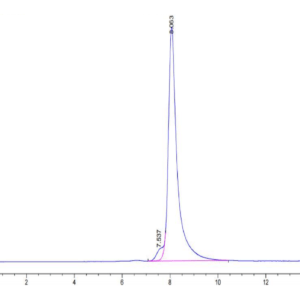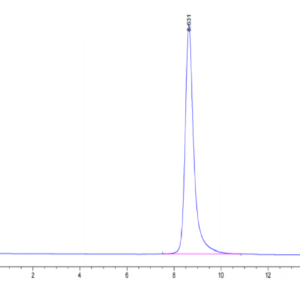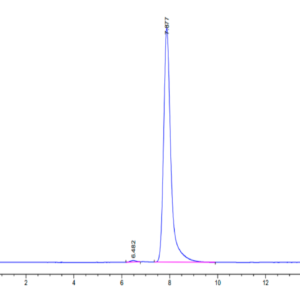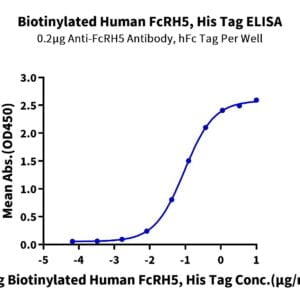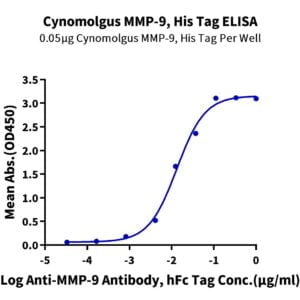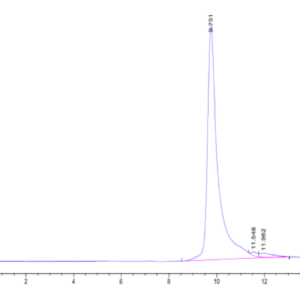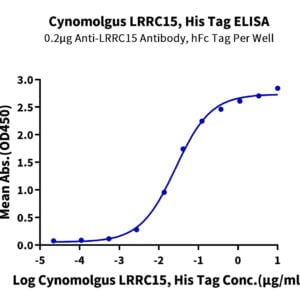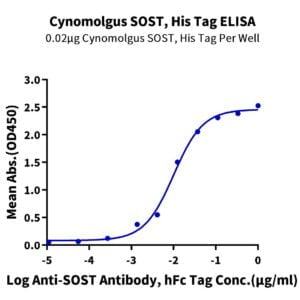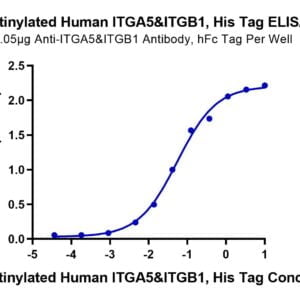| Weight | 1 lbs |
|---|---|
| Dimensions | 9 × 5 × 2 in |
| accession | Q9BYF1 |
| express system | HEK293 |
| product tag | C-His-Avi |
| purity | > 95% as determined by Tris-Bis PAGE;> 95% as determined by HPLC |
| background | ACE2 (Angiotensin I Converting Enzyme 2) is a Protein Coding gene. Diseases associated with ACE2 include Severe Acute Respiratory Syndrome and Neurogenic Hypertension.The protein encoded by this gene belongs to the angiotensin-converting enzyme family of dipeptidyl carboxydipeptidases and has considerable homology to human angiotensin 1 converting enzyme. This secreted protein catalyzes the cleavage of angiotensin I into angiotensin 1-9, and angiotensin II into the vasodilator angiotensin 1-7. |
| molecular weight | The protein has a predicted MW of 86.5 kDa. Due to glycosylation, the protein migrates to 95-110 kDa based on Tris-Bis PAGE result. |
| available size | 100 µg, 500 µg |
| endotoxin | Less than 1EU per μg by the LAL method. |
Human ACE2/ACEH Protein 4664
$270.00 – $900.00
Summary
- Expression: HEK293
- Functional: Yes (ELISA)
- Amino Acid Range: Gln18-Ser740
Human ACE2/ACEH Protein 4664
| protein |
|---|
| Size and concentration 100, 500µg and lyophilized |
| Form Lyophilized |
| Storage Instructions Valid for 12 months from date of receipt when stored at -80°C. Recommend to aliquot the protein into smaller quantities for optimal storage. Please minimize freeze-thaw cycles. |
| Storage buffer Shipped at ambient temperature. |
| Purity > 95% as determined by Tris-Bis PAGE |
| target relevance |
|---|
| ACE2 (Angiotensin I Converting Enzyme 2) is a Protein Coding gene. Diseases associated with ACE2 include Severe Acute Respiratory Syndrome and Neurogenic Hypertension.The protein encoded by this gene belongs to the angiotensin-converting enzyme family of dipeptidyl carboxydipeptidases and has considerable homology to human angiotensin 1 converting enzyme. This secreted protein catalyzes the cleavage of angiotensin I into angiotensin 1-9, and angiotensin II into the vasodilator angiotensin 1-7. |
| Protein names Angiotensin-converting enzyme 2 (EC 3.4.17.23) (Angiotensin-converting enzyme homolog) (ACEH) (Angiotensin-converting enzyme-related carboxypeptidase) (ACE-related carboxypeptidase) (EC 3.4.17.-) (Metalloprotease MPROT15) [Cleaved into: Processed angiotensin-converting enzyme 2] |
| Gene names ACE2,ACE2 UNQ868/PRO1885 |
| Protein family Peptidase M2 family |
| Mass 92463Da |
| Function Essential counter-regulatory carboxypeptidase of the renin-angiotensin hormone system that is a critical regulator of blood volume, systemic vascular resistance, and thus cardiovascular homeostasis (PubMed:27217402). Converts angiotensin I to angiotensin 1-9, a nine-amino acid peptide with anti-hypertrophic effects in cardiomyocytes, and angiotensin II to angiotensin 1-7, which then acts as a beneficial vasodilator and anti-proliferation agent, counterbalancing the actions of the vasoconstrictor angiotensin II (PubMed:10969042, PubMed:10924499, PubMed:11815627, PubMed:19021774, PubMed:14504186). Also removes the C-terminal residue from three other vasoactive peptides, neurotensin, kinetensin, and des-Arg bradykinin, but is not active on bradykinin (PubMed:10969042, PubMed:11815627). Also cleaves other biological peptides, such as apelins (apelin-13, [Pyr1]apelin-13, apelin-17, apelin-36), casomorphins (beta-casomorphin-7, neocasomorphin) and dynorphin A with high efficiency (PubMed:11815627, PubMed:27217402, PubMed:28293165). In addition, ACE2 C-terminus is homologous to collectrin and is responsible for the trafficking of the neutral amino acid transporter SL6A19 to the plasma membrane of gut epithelial cells via direct interaction, regulating its expression on the cell surface and its catalytic activity (PubMed:18424768, PubMed:19185582).; (Microbial infection) Acts as a receptor for human coronaviruses SARS-CoV and SARS-CoV-2, as well as human coronavirus NL63/HCoV-NL63.; [Isoform 2]: Non-functional as a carboxypeptidase.; [Isoform 2]: (Microbial infection) Non-functional as a receptor for human coronavirus SARS-CoV-2. |
| Catalytic activity CATALYTIC ACTIVITY: Reaction=angiotensin II + H2O = angiotensin-(1-7) + L-phenylalanine; Xref=Rhea:RHEA:26554, ChEBI:CHEBI:15377, ChEBI:CHEBI:58095, ChEBI:CHEBI:58506, ChEBI:CHEBI:58922; EC=3.4.17.23; Evidence=; PhysiologicalDirection=left-to-right; Xref=Rhea:RHEA:26555; Evidence=; CATALYTIC ACTIVITY: Reaction=angiotensin I + H2O = angiotensin-(1-9) + L-leucine; Xref=Rhea:RHEA:63532, ChEBI:CHEBI:15377, ChEBI:CHEBI:57427, ChEBI:CHEBI:147350, ChEBI:CHEBI:147351; Evidence=; PhysiologicalDirection=left-to-right; Xref=Rhea:RHEA:63533; Evidence=; CATALYTIC ACTIVITY: Reaction=bradykinin(1-8) + H2O = bradykinin(1-7) + L-phenylalanine; Xref=Rhea:RHEA:63536, ChEBI:CHEBI:15377, ChEBI:CHEBI:58095, ChEBI:CHEBI:133069, ChEBI:CHEBI:147352; Evidence=; PhysiologicalDirection=left-to-right; Xref=Rhea:RHEA:63537; Evidence=; CATALYTIC ACTIVITY: Reaction=H2O + neurotensin = L-leucine + neurotensin-(1-12); Xref=Rhea:RHEA:63540, ChEBI:CHEBI:15377, ChEBI:CHEBI:57427, ChEBI:CHEBI:147362, ChEBI:CHEBI:147363; Evidence=; PhysiologicalDirection=left-to-right; Xref=Rhea:RHEA:63541; Evidence=; CATALYTIC ACTIVITY: Reaction=H2O + neurotensin-(1-8) = L-arginine + neurotensin-(1-7); Xref=Rhea:RHEA:63572, ChEBI:CHEBI:15377, ChEBI:CHEBI:32682, ChEBI:CHEBI:147393, ChEBI:CHEBI:147394; Evidence=; PhysiologicalDirection=left-to-right; Xref=Rhea:RHEA:63573; Evidence=; CATALYTIC ACTIVITY: Reaction=H2O + kinetensin = kinetensin-(1-8) + L-leucine; Xref=Rhea:RHEA:63544, ChEBI:CHEBI:15377, ChEBI:CHEBI:57427, ChEBI:CHEBI:147364, ChEBI:CHEBI:147365; Evidence=; PhysiologicalDirection=left-to-right; Xref=Rhea:RHEA:63545; Evidence=; CATALYTIC ACTIVITY: Reaction=dynorphin A-(1-13) + H2O = dynorphin A-(1-12) + L-lysine; Xref=Rhea:RHEA:63556, ChEBI:CHEBI:15377, ChEBI:CHEBI:32551, ChEBI:CHEBI:147381, ChEBI:CHEBI:147383; Evidence=; PhysiologicalDirection=left-to-right; Xref=Rhea:RHEA:63557; Evidence=; CATALYTIC ACTIVITY: Reaction=apelin-13 + H2O = apelin-12 + L-phenylalanine; Xref=Rhea:RHEA:63564, ChEBI:CHEBI:15377, ChEBI:CHEBI:58095, ChEBI:CHEBI:147395, ChEBI:CHEBI:147396; Evidence=; PhysiologicalDirection=left-to-right; Xref=Rhea:RHEA:63565; Evidence=; CATALYTIC ACTIVITY: Reaction=[Pyr1]apelin-13 + H2O = [Pyr1]apelin-12 + L-phenylalanine; Xref=Rhea:RHEA:63604, ChEBI:CHEBI:15377, ChEBI:CHEBI:58095, ChEBI:CHEBI:147415, ChEBI:CHEBI:147416; Evidence=; PhysiologicalDirection=left-to-right; Xref=Rhea:RHEA:63605; Evidence=; CATALYTIC ACTIVITY: Reaction=apelin-17 + H2O = apelin-16 + L-phenylalanine; Xref=Rhea:RHEA:63608, ChEBI:CHEBI:15377, ChEBI:CHEBI:58095, ChEBI:CHEBI:147421, ChEBI:CHEBI:147422; Evidence=; PhysiologicalDirection=left-to-right; Xref=Rhea:RHEA:63609; Evidence=; CATALYTIC ACTIVITY: Reaction=beta-casomorphin-7 + H2O = beta-casomorphin-6 + L-isoleucine; Xref=Rhea:RHEA:63568, ChEBI:CHEBI:15377, ChEBI:CHEBI:58045, ChEBI:CHEBI:147390, ChEBI:CHEBI:147391; Evidence=; PhysiologicalDirection=left-to-right; Xref=Rhea:RHEA:63569; Evidence=; CATALYTIC ACTIVITY: Reaction=H2O + neocasomorphin = L-isoleucine + neocasomorphin-(1-5); Xref=Rhea:RHEA:63600, ChEBI:CHEBI:15377, ChEBI:CHEBI:58045, ChEBI:CHEBI:147417, ChEBI:CHEBI:147418; Evidence=; PhysiologicalDirection=left-to-right; Xref=Rhea:RHEA:63601; Evidence=; |
| Subellular location [Processed angiotensin-converting enzyme 2]: Secreted .; Cell membrane ; Single-pass type I membrane protein. Cytoplasm. Cell projection, cilium. Apical cell membrane. Note=Detected in both cell membrane and cytoplasm in neurons.; [Isoform 2]: Apical cell membrane . |
| Tissues Expressed in endothelial cells from small and large arteries, and in arterial smooth muscle cells (at protein level) (PubMed:15141377). Expressed in enterocytes of the small intestine, Leydig cells and Sertoli cells (at protein level) (PubMed:15141377). Expressed in the renal proximal tubule and the small intestine (at protein level) (PubMed:18424768). Expressed in heart, kidney, testis, and gastrointestinal system (at protein level) (PubMed:10969042, PubMed:10924499, PubMed:15231706, PubMed:12459472, PubMed:15671045, PubMed:32715618, PubMed:32170560). In lung, expressed at low levels in some alveolar type 2 cells, the expression seems to be individual-specific (at protein level) (PubMed:32425701, PubMed:15141377, PubMed:32715618, PubMed:32170560, PubMed:33432184). Expressed in nasal epithelial cells (at protein level) (PubMed:33432184, PubMed:32333915). Coexpressed with TMPRSS2 within some lung alveolar type 2 cells, ileal absorptive enterocytes, intestinal epithelial cells, cornea, gallbladder and nasal goblet secretory cells (PubMed:32413319, PubMed:32327758, PubMed:32358202). Coexpressed with TMPRSS4 within mature enterocytes (PubMed:32404436).; [Isoform 2]: Expressed in nasal and bronchial epithelial cells (at protein level). |
| Structure Homodimer (PubMed:32132184). Interacts with the catalytically active form of TMPRSS2 (PubMed:21068237). Interacts with SLC6A19; this interaction is essential for expression and function of SLC6A19 in intestine (By similarity). Interacts with ITGA5:ITGB1 (PubMed:15276642, PubMed:33102950). Probably interacts (via endocytic sorting signal motif) with AP2M1; the interaction is inhibited by phosphorylation of Tyr-781 (PubMed:33436498). Interacts (via PDZ-binding motif) with NHERF1 (via PDZ domains); the interaction may enhance ACE2 membrane residence (PubMed:34189428).; (Microbial infection) Interacts with SARS coronavirus/SARS-CoV spike protein.; (Microbial infection) Interacts with SARS coronavirus-2/SARS-CoV-2 spike protein (via RBD domain).; (Microbial infection) Interacts with human coronavirus NL63 spike protein.; (Microbial infection) Interacts with human coronavirus NL63/HCoV-NL63 spike glycoprotein.; [Processed angiotensin-converting enzyme 2]: (Microbial infection) Interacts with SARS coronavirus-2/SARS-CoV-2 spike protein; the interaction is increased by AVP/Arg-vasopressin with which they may form a complex. |
| Post-translational modification N-glycosylation on Asn-90 may limit SARS infectivity.; Proteolytic cleavage by ADAM17 generates a secreted form (PubMed:15983030, PubMed:33713620). Also cleaved by serine proteases: TMPRSS2, TMPRSS11D and HPN/TMPRSS1.; Phosphorylated. Phosphorylation at Tyr-781 probably inhibits interaction with AP2M1 and enables interactions with proteins containing SH2 domains. |
| Domain TOPO_DOM 1 |
| Biotechnology BIOTECHNOLOGY: An engeneered stable, dimeric and secreted receptor with combined mutations that increase the affinity for human coronavirus SARS-CoV-2 spike protein shows potent SARS-CoV and SARS-CoV-2 neutralization in vitro. |
| Target Relevance information above includes information from UniProt accession: Q9BYF1 |
| The UniProt Consortium |
Data
Publications
Publications
| pmid | title | authors | citation |
|---|---|---|---|
| We haven't added any publications to our database yet. | |||
Protocols
| relevant to this product |
|---|
Documents
| # | ||
|---|---|---|
| Please enter your product and batch number here to retrieve product datasheet, SDS, and QC information. | ||
